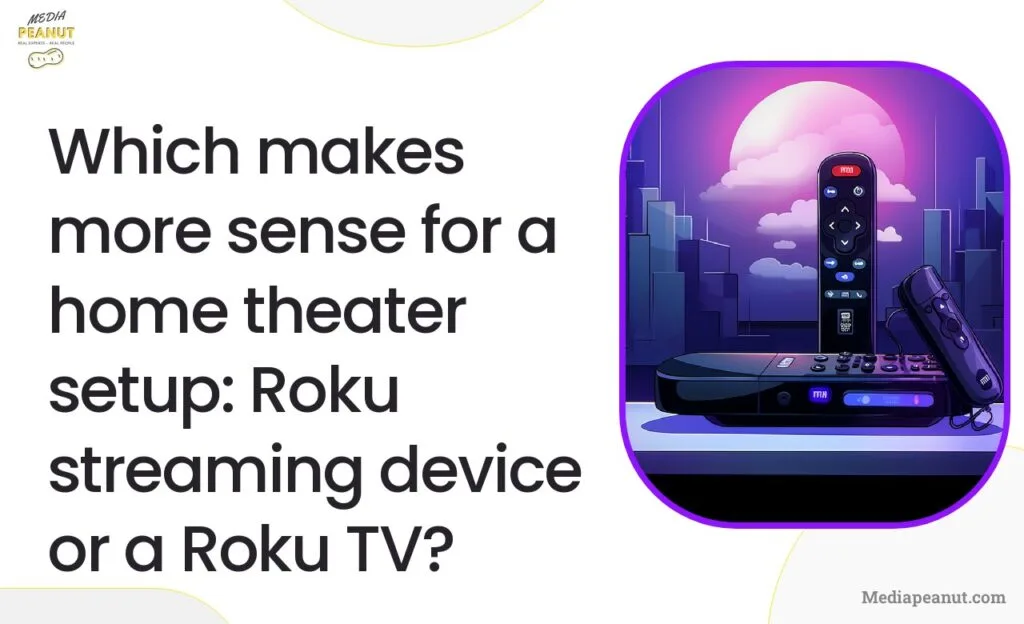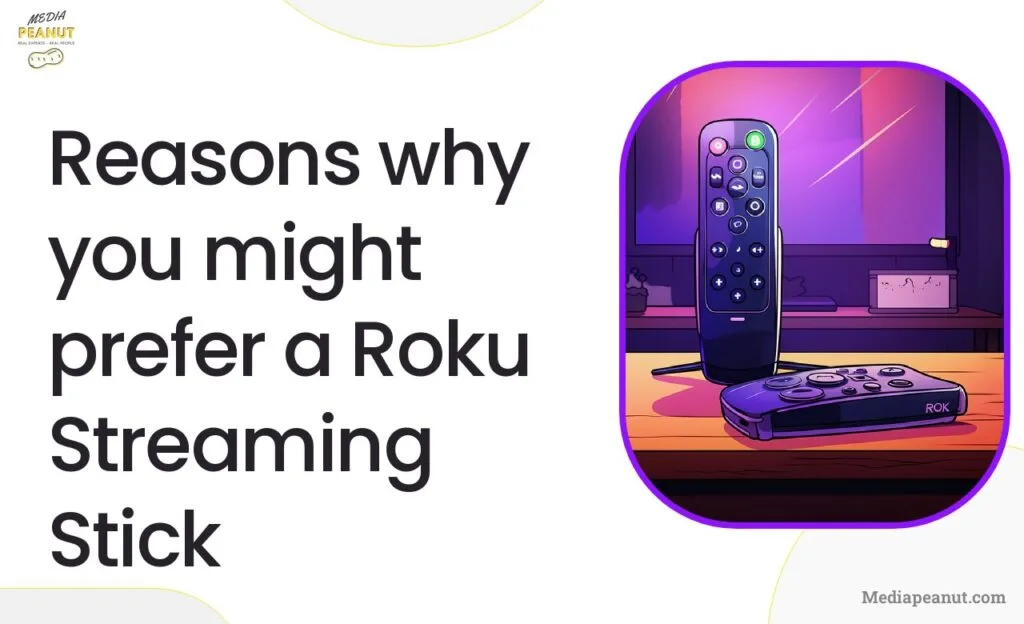Roku is a household name in the world of streaming, offering a range of devices like the Roku TV, Roku Sticks, and Roku streaming players.
From the built-in operating system of Roku TV to the portability of the Roku Streaming Stick and the premium features of Roku Ultra, the brand ensures everyone has a suitable streaming solution.
See Every Roku Device Compared
But with the variety of options available, it can be challenging to understand their distinct features and determine which is right for you.
We’ll dive deep into the differences and help you understand the difference between the Roku TV and Roku streaming devices like the Roku Stick 4K and the Roku Ultra.

- How are Roku TVs and Roku streaming players different?
- Which makes more sense for a home theater setup: Roku streaming device or a Roku TV?
- Roku devices vs Roku TV: Main advantages and drawbacks for streaming
- Deep Dive comparative analysis: Roku devices vs Roku TV
- Making the Choice: User Recommendations on Roku Device and Roku TV
- Real-life Experiences: Using Roku Device and Roku TV
- Hardware analysis of Roku devices (including Roku TV)
- FAQ
- Conclusion
How are Roku TVs and Roku streaming players different?

Roku TVs and Roku streaming devices are products under the Roku brand, but there is a difference between the two. Roku TVs are different from Roku streaming devices and as they has Roku OS built into the TV without needing a separate device.

- Comparing the hardware between the Roku TV and the standalone Roku device is challenging without specific chip details (see current Roku model CPUs’), but the main difference lies in any additional features the standalone device might offer.
- Some users have faced issues with the built-in Roku OS, especially with specific apps like Plex, despite being technically literate and troubleshooting extensively.
- Many users prefer standalone devices because they’re easily replaceable, whereas issues with built-in systems can render a TV useless or lead to costly replacements.
| Image | Title | Price | Prime | Buy |
|---|---|---|---|---|
 | Roku Streaming Stick 4K | PrimeEligible | View at Amazon | |
 | Roku Ultra | PrimeEligible | View at Amazon | |
 | Roku Express | PrimeEligible | View at Amazon | |
 | TCL 32" Roku Smart TV | PrimeEligible | View at Amazon | |
 | Westinghouse Roku TV - 42 Inch | PrimeEligible | View at Amazon | |
 | TCL 50-Inch Roku TV | PrimeEligible | View at Amazon | |
 | Hisense 65-Inch Class R6 Series 4K UHD Roku TV | PrimeEligible | View at Amazon | |
 | RCA 32-inch Flat Screen 1080p Roku Smart LED TV | PrimeEligible | View at Amazon |
| Feature/Aspect | Roku TV | Roku Streaming Stick | Roku Ultra |
|---|---|---|---|
| Device Type | Smart TV | Streaming device | Premium streaming box |
| Built-in Roku OS | Yes | No | No |
| 4K HDR Streaming | Varies by model | Varies by model | Yes |
| Portability | No | Yes | No (but can be moved easily) |
| Voice Control | Yes | Varies by model | Yes |
| Ethernet Port | Varies by model | No | Yes |
| USB Port | Varies by model | No | Yes |
| Remote with Headphone | Varies by model | Varies by model | Yes |
| Price Range | Varies (few hundred to over a thousand) | Generally affordable | Around $100 |
Roku TV is a smart TV with the Roku operating system built-in, eliminating the need for an external streaming device. It offers a seamless user experience, with the Roku platform’s extensive library of streaming channels directly accessible from the TV’s home screen.
Roku TV models also incorporate additional features like voice control, private listening, and the ability to pause live TV.

The Roku Streaming Stick, on the other hand, is a portable device that plugs into the HDMI port of your TV, effectively turning a regular TV into a smart TV. It allows you to stream content from a wide range of channels and platforms. The Streaming Stick is compact and portable, making it a great option for those who travel frequently.

Roku Ultra is the high-end streaming box in the Roku lineup. It supports 4K HDR streaming and includes premium features like an Ethernet port for a more stable internet connection, a USB port for local media playback, and a remote with voice control and headphone jack for private listening.
See: Discover the Best Roku TVs on the market
In essence, while all three devices provide access to the Roku platform, Roku TV is a television with Roku built-in, the Streaming Stick is a portable device that turns any TV into a smart TV, and the Roku Ultra is a premium streaming box offering the most advanced features.
Which makes more sense for a home theater setup: Roku streaming device or a Roku TV?

Choosing between a Roku streaming device and a Roku TV depends on your specific needs, preferences, and circumstances.
| Reasons/Considerations | Roku TV | Roku Streaming Stick/Ultra |
|---|---|---|
| Already own a TV | – | Strong choice |
| Looking for a new TV | Suitable | – |
| Portability | – | Suitable |
| All-in-one solution | Suitable | – |
| Advanced features | – | More prominent in Roku Ultra |
Reasons why you might prefer a Roku TV

Roku TV might be a better choice if you’re in the market for a new TV and prefer an all-in-one solution. With Roku TV, you don’t need to worry about setting up an additional device or managing multiple remotes.
The Roku platform is integrated directly into the TV, providing a seamless user experience. Roku TVs also have additional features like voice control and the ability to pause live TV. If you value simplicity and convenience, a Roku TV could be the right choice for you.
Dive deeper into the benefits of the Roku TV with our detailed article on how a Roku TV works
Reasons why you might prefer a Roku Streaming Stick

On the other hand, a Roku Streaming Stick or Roku Ultra might be more suitable if you already have a TV that you’re happy with and just want to add smart capabilities.
These devices can turn any TV with an HDMI port into a smart TV, giving you access to the Roku platform and its extensive library of streaming channels. They’re also a good option if you travel frequently and want to take your streaming device with you. Furthermore, if you want to enjoy the most advanced features like 4K HDR streaming and a more stable internet connection via Ethernet, the Roku Ultra could be the best choice.
Discover more about the Roku Streaming Stick in our Roku stick 4k plus review.
Roku devices vs Roku TV: Main advantages and drawbacks for streaming

When it comes to streaming, both Roku devices and Roku TVs offer several advantages and some drawbacks.
If you’re wondering about the broader spectrum of streaming options, read our comparison between determining whether the Firestick or Roku is the better device for streaming.
Advantages and Drawbacks for Streaming

| Aspect | Roku TV | Roku Devices |
|---|---|---|
| Versatility | Built-in Roku OS | Turn any TV into a smart TV |
| Portability | No | Yes |
| User Experience | Seamless (integrated platform) | Requires additional device |
| Additional Remote | No | Yes |
| Potential Outdated OS | Yes (harder to replace) | No (easier to replace) |
| Picture Quality | Varies (typically mid-range) | Dependent on TV used with |
One of the main advantages of Roku devices, including the Streaming Stick and Ultra, is their versatility. They can turn any TV with an HDMI port into a smart TV, giving you access to a vast array of streaming channels and platforms. They’re also portable, so you can take them with you when you travel.
Roku TVs, on the other hand, offer the convenience of having the Roku platform built directly into the TV. This eliminates the need for an additional device and remote, providing a more seamless user experience. Roku TVs also often include additional features like voice control and the ability to pause live TV.
However, there are also some drawbacks to consider. With Roku devices, you’ll need to manage an additional remote and potentially deal with more cables.
On the other hand, while Roku TVs offer a streamlined experience, they may not offer the same level of picture quality as high-end TVs from brands like Samsung or Sony.
Also.. if the Roku platform becomes outdated or malfunctions, you can’t simply replace it like you can with a Roku device.
Deep Dive comparative analysis: Roku devices vs Roku TV

To understand the differences between Roku devices and Roku TV, let’s dive deeper into their features and performance.
What is Roku: An Overview

Roku is a brand known for its streaming devices and smart TVs. The Roku platform offers access to a vast array of streaming channels, including popular platforms like Netflix, Amazon Prime Video, Hulu, and Disney+.
Roku devices, including the Roku Streaming Stick and Roku Ultra, can be connected to any TV with an HDMI port, effectively turning it into a smart TV. Roku TVs, on the other hand, have the Roku platform built directly into the TV.
Get a more detailed explanation of the Roku platform in our post on what exactly a Roku does.
Roku TV: A Closer Look

Roku TVs offer a seamless user experience, with the Roku platform’s extensive library of streaming channels directly accessible from the TV’s home screen. These TVs also incorporate additional features like voice control, private listening, and the ability to pause live TV.
However, Roku TVs are typically made by budget to mid-range brands and may not offer the same level of picture quality as high-end TVs from brands like Samsung or Sony.
Learn about the leading brands with our guide on the Best Roku TV brands including TCL and Hisense.
Different Types of Roku TVs

Over the years, various brands have partnered with Roku to produce these TVs. Here’s a breakdown of some of the best Roku TVs in 2023 and how they differ:
- TCL (65R655)
- Features: 144Hz refresh rate when connected to a PC, superb color and brightness, THX Certified Game Mode, auto low-latency mode, and variable refresh rate.
- Pros: Terrific brightness levels, strong gaming performance, huge app selection, and improved Roku remote.
- Cons: Mediocre sound and limited HDMI 2.1 ports.
- Roku Plus Series
- Features: Roku’s own TV series with QLED technology.
- Pros: Excellent value, first-rate HDR color, good sound, and solid Roku TV smart interface.
- Cons: So-so brightness, only 60Hz refresh rate, and no HDMI 2.1 ports.
- TCL 6-Series 55R635 (2020)
- Features: Older model with QLED and mini-LED display, THX Certified Game Mode, auto low-latency mode, and variable refresh rate.
- Pros: Excellent display, great gaming performance, huge app selection, and improved Roku remote.
- Cons: Sound is a bit weak.
- TCL 5-Series Roku TV 55S535
- Features: LCD with Quantum dot, Dolby Vision, HDR10, and HLG formats.
- Pros: Faithful colors, built-in Roku smarts, and excellent price.
- Cons: Mediocre sound and modest brightness.
- TCL 4-Series Roku TV 43S435
- Features: LED display, supports HDR10.
- Pros: Excellent value-priced 4K, good color fidelity, and solid Roku skills.
- Cons: No Dolby Vision support, minimal sound adjustments, and picture adjustments are hard to find.
- TCL 6-Series 8K Roku TV (65R648)
- Features: 8K resolution, QLED + Mini-LED display, 120Hz refresh rate.
- Pros: Good picture quality, well-conceived remote redesign, and fine gaming performance.
- Cons: 65-inch model struggles to prove the worth of 8K resolution, very little 8K content available, poor off-angle viewing, and mediocre sound.
Differences:
- Resolution: While most of the models offer 1080P OR 4K resolution, the TCL 6-Series 8K Roku TV (65R648) stands out with 8K resolution.
- Display Technology: Some models use QLED technology, which offers better color and brightness (this looked amazing when I tested it). The TCL 6-Series 55R635 and TCL 6-Series 8K Roku TV (65R648) also incorporate mini-LED backlighting.
- Refresh Rate: Higher refresh rates like 144Hz or 120Hz offer smoother motion, especially beneficial for gaming. Some models, however, are limited to 60Hz.
- Price: Roku TVs range from budget-friendly to more premium models. For instance, the TCL 4-Series is more affordable, while the TCL 6-Series 8K is on the pricier side due to its advanced features.
I do have to note that while TCL has been a dominant player in the Roku TV market, other brands like Hisense have also produced Roku TVs in the past. However, in recent times, brands like Hisense have appeared to shift more towards Google’s smart TV platform.
For a more detailed understanding and to make an informed decision, it’s always good to check individual reviews and compare models based on your requirements and budget.
Also see the Mediapeanut Podcast where we have tech focused talks on various electronics, streaming devices, and streaming platforms.
Evaluating Picture Quality: Roku Device vs Roku TV
When it comes to picture quality, there can be significant differences between Roku devices and Roku TVs.
Roku devices, especially the Roku Ultra, support 4K HDR streaming, delivering excellent picture quality when paired with a high-quality TV.
Roku TVs, on the other hand, typically fall in the mid or lower range for picture quality and aren’t priced as high as Samsung or LG TVs I’ve tested. While many Roku TVs support 4K, many models lack HDR, which enhances color vividness.
Cost Analysis: Roku Device and Roku TV
In terms of cost, Roku devices are generally more affordable than Roku TVs. The Roku Ultra, Roku’s most expensive device, is priced around $100. Roku TVs, on the other hand, can range from a few hundred to over a thousand dollars, depending on the model and size. However, keep in mind that with a Roku TV, you’re getting an all-in-one solution, whereas with a Roku device, you’ll need to have a separate TV.
If you’re budget-conscious, don’t miss our Roku Ultra LT Review for an in-depth cost analysis.
Making the Choice: User Recommendations on Roku Device and Roku TV
Choosing between a Roku device and a Roku TV ultimately comes down to your specific needs and circumstances. If you’re in the market for a new TV and prefer an all-in-one solution, a Roku TV could be a great choice. On the other hand, if you already have a TV that you’re happy with and just want to add smart capabilities, a Roku Streaming Stick or Roku Ultra could be a better fit.
Related: How to Use a Streaming Device on an older TV
Real-life Experiences: Using Roku Device and Roku TV
| Questions/Topics | Answers/Insights |
|---|---|
| Streaming Experience | Both offer similar experiences; Roku TV is more seamless while devices offer versatility. |
| Reason for Roku Device | Suitable for those with existing TVs or those wanting portability. |
| Conclusion | Choice depends on needs: Roku TV for an all-in-one solution, devices for enhancing existing TVs. |
Many users have shared their experiences with using Roku devices and Roku TVs. Some users prefer the simplicity and convenience of a Roku TV, which offers a seamless user experience with the Roku platform directly integrated into the TV. Others appreciate the versatility and portability of Roku devices, which can turn any TV into a smart TV and be taken on the go.
Who should use which device and why?
If you prioritize picture quality and already have a high-quality TV, a Roku device like the Roku Ultra could be the best choice. It supports 4K HDR streaming and offers advanced features like an Ethernet port for a more stable internet connection. However, if you’re looking for a new TV and are content with good (but not the absolute best) picture quality, a Roku TV could be a great all-in-one solution.
For real-life scenarios, read about Real-life Experiences: Using Roku Device and Roku TV.
Hardware analysis of Roku devices (including Roku TV)
Current Roku Models:
- Range of CPU: The current models (As of 2023) have CPUs ranging from ARM Cortex A35 to ARM Cortex A55 and ARM quad core CA73 1 GHz.
- RAM: The RAM varies from 512 MB to 2 GB.
- Max UI Resolution: The majority of the devices support 1080p/60fps, with some supporting only 720p.
- Max Playback Resolution: Devices range from 1080p to 8K playback capabilities.
- HDR Support: Most of the current models support HDR, with some variations in the type of HDR supported (source)
Updatable Roku Models:
- Range of CPU: The updatable models have CPUs ranging from MIPS 900 MHz to ARM Cortex A55.
- RAM: The RAM varies from 512 MB to 2 GB.
- Max UI Resolution: Most devices support 720p or 1080p.
- Max Playback Resolution: Devices range from 1080p to 4K playback capabilities.
- HDR Support: Many of the updatable models support HDR, with some variations in the type of HDR supported.
Legacy Roku Models:
- Range of CPU: The legacy models have CPUs ranging from MIPS 400 MHz to ARM11 600 MHz.
- RAM: The RAM is either 256 MB or 512 MB.
- Latest Roku OS version: The legacy models support Roku OS versions ranging from 3.1 to 11.5.
Observations:
- Performance: As expected, the current models have better specifications in terms of CPU and RAM compared to updatable and legacy models. This means they are likely to offer better performance and handle more intensive tasks.
- Resolution: The current models also support higher resolutions, both in terms of UI and playback. This is particularly evident with the introduction of 8K playback in the current models.
- HDR Support: HDR support is more prevalent in the current and updatable models. This means they can offer better color depth and contrast in supported content.
- Legacy Limitations: Legacy models are limited in terms of both hardware specifications and software support. They can’t run the latest Roku OS versions, which means they might miss out on new features and security updates.
Recommendations:
- For developers or users looking for the best performance and future-proofing, it’s recommended to focus on the current models.
- If budget is a concern, updatable models can still offer a good experience, especially those that support 4K and HDR.
- Legacy models are best suited for basic tasks and might not be the best choice for new purchases given their limitations.
Current Roku TV Models:
| Device Name | Code Name | roDeviceInfo.GetModel() | CPU | RAM | Max UI Resolution | Max Playback Resolution | HDR Support |
|---|---|---|---|---|---|---|---|
| 4K Roku TV | Trinidad | J000X | ARM quad core CA73 1 GHz | 2 GB | 1080p/60fps | 4K144fps, HDR | HDR10, HDR10+, HLG, and Dolby Vision |
| 4K Roku TV | Longview | 7000X | ARM dual core 1.2 GHz | 1 GB | 1920X1080 | 3840×2160 | HDR10 and/or Dolby Vision supported, varies by model |
| Roku TV | Midland | 8000X | ARM | 512 MB | 720p | 1080p | No |
| Roku TV | Roxton | K000X | ARM Cortex A35 | 512 MB | 720p | 1080p/60fps | No |
| Roku TV (Brazil) | El Paso | 8000X | ARM | 512 MB | 720p | 1080p | No |
| 2K Roku TV | Miami | H000X | ARM quad core 1 GHz | 512MB | 720p | 1080p/60fps | No |
| 4K Roku TV | Reno | A000X | ARM quad core 1 GHz | 1.5 GB | 1920X1080 | 3840×2160 | HDR10, Dolby Vision, and HLG supported, varies by model |
| 4K Roku TV | Malone | C000X | ARM quad core 1 GHz | 1 GB | 1920X1080 | 3840×2160 | HDR10, Dolby Vision, and HLG supported, varies by model |
| 4K Roku TV | Athens | G000X | ARM quad core 1 GHz | 1 GB | 1920X1080 | 3840×2160 | HDR10, Dolby Vision, and HLG supported, varies by model |
| 4K Roku TV (EU) | Camden | C000GB | ARM quad core 1 GHz | 1 GB | 1920X1080 | 3840×2160 | HDR10, Dolby Vision, and HLG supported, varies by model |
| 8K Roku TV | Bandera | E000X | ARM quad core 1 GHz | 1.5 GB | 1920X1080 | 7,680×4,320 | HDR10, Dolby Vision, and HLG supported, varies by model |
Updatable Roku TV Models:
| Device Name | Code Name | roDeviceInfo.GetModel() | CPU | RAM | Max UI Resolution | Max Playback Resolution | HDR Support |
|---|---|---|---|---|---|---|---|
| Roku TV | Liberty | 5000X | MIPS 1 GHz | 512 MB | 1280X720 | 1920×1080, 60fps** | n/a |
| 4K Roku TV | Ft. Worth | 6000X | ARM quad core | 1.5 GB | 1920X1080 | 3840X2160 | N/a |
| Roku TV | Roma | D000X | ARM Cortex A55 | 512 MB | 720p | 1080p | No |
FAQ
Do Roku and Roku TV have different streaming experiences?
Roku devices and Roku TVs offer similar streaming experiences, as they both provide access to the Roku platform and its extensive library of streaming channels. However, Roku TVs offer a more seamless user experience, with the Roku platform directly integrated into the TV. This eliminates the need for an additional device and remote. On the other hand, Roku devices like the Streaming Stick and Ultra can turn any TV into a smart TV, offering versatility and portability.
Why would I get a Roku when I can get a Roku TV with Roku OS Built-in?
Getting a Roku device can be a good option if you already have a TV that you’re happy with and just want to add smart capabilities. Roku devices can turn any TV with an HDMI port into a smart TV, giving you access to the Roku platform and its extensive library of streaming channels. They’re also portable, so you can take them with you when you travel or move them between different TVs in your home.
Do Roku TVs work outside?
Using a Roku TV outside is possible but not advised without precautions. Standard Roku TVs aren’t weatherproof and can be affected by temperature extremes, humidity, and direct sunlight. Outdoor viewing might also be hindered by glare, and you’ll need a strong Wi-Fi connection, a safe power source, and potentially external speakers.
However, there are dedicated outdoor Roku TVs that was first announced in May 2022 on the official Roku website, these are built to work in winter -4°F all the way to 104°F.
There’s also the risk of dust accumulation, insect attraction, and theft. For outdoor use, consider specialized outdoor TVs designed for such conditions or protective enclosures for your Roku TV to shield it from the elements.
Conclusion
Roku TV and Roku devices both offer access to the Roku platform and its extensive library of streaming channels. The choice between them depends on your specific needs and circumstances. If you’re looking for a new TV and prefer an all-in-one solution, a Roku TV could be a great choice. On the other hand, if you already have a TV that you’re happy with and just want to add smart capabilities, a Roku Streaming Stick or Roku Ultra could be a better fit.


